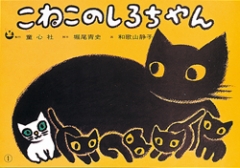
-
Blanc,le petit chanton
Koneko no Shiro-chan
Seishi Horio, Shizuko Wakayama / 12 sheets
His mother and his siblings are all black, but little kitten Shiro-chan is white. His feelings as he longs to turn black touch the heart of the audience, thanks to Seishi Horio’s text plus Shizuko Wakayama’s illustrations, which possess a unique charm. The kamishibai gives children a feeling of delight and happiness in being themselves, just the way they are.
Sa mère et ses frères et soeurs ont tous un pelagenoir, sauf Blanc le petit chaton qui a une fourruretoute blanche. Il est différent, on dirait qu’il vientd’ailleurs. Pour devenir noir comme toute sa famille,Blanc prend un bain de boue ; mais sa maman letrouve, le nettoie et le prend dans ses pattes où ilfinit par faire la sieste. Pourtant, Blanc veutvraiment devenir noir : il trouve alors un pot depeinture noire… Les aventures de Blanc le chatontiennent le public en haleine jusqu’à la dernièrescène, où il rencontre un beau chat blanc : son père.Il comprend alors pourquoi sa fourrure est blanche,et découvre la fierté d’être lui-même. Unkamishibai qui permet aux enfants de partager lessentiments de Blanc le petit chaton.- ISBN978-4-494-07922-3
- ¥3,300E
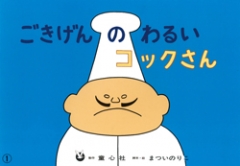
-
Le chef cuisinier est de mauvais poil
Gokigen no warui kokku-san
Noriko Matsui / 12 sheets
This work makes deliberate use of the motion of sliding out sheets. As the audience calls “Look over here!” to Mr. Cook, who has turned his back in irritation at things around him, he turns and begins to cook something of his own, which delights everybody. The joy of eating candy all together becomes fused with the joy of living life just as we are, producing a deep sense of kyokan.
Le chef cuisinier est de mauvais poil. Quand ontire la page sur le côté en disant « Retrouvezvotre bonne humeur ! », aïe aïe aïe, le visage duchef s’étire et il est d’encore plus mauvaisehumeur ! Comment faire ? A chaque page, levisage du chef cuisinier se déforme suivant lafaçon dont on tire la page. Et quand les enfantscrient « Chef, regardez-nous ! »…En dernier apparaissent des bonbons à partageravec tout le monde. Un kamishibai très appréciépour sa grande créativité et la participation dupublic.- ISBN978-4-494-07923-0
- ¥3,300E
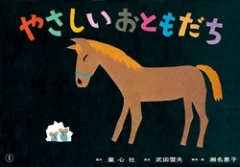
-
De bons amis
Yasashii otomodachi
Yukio Takeda, Keiko Sena / 12 sheets
Keiko Sena has long explored the possibilities of harie (pasted paper) in her work as a picture book and kamishibai artist. The simplicity of her illustrations lends itself perfectly to this work. Thanks also to the vivid colors, both the friendship between a horse and some mice and the feeling of urgency when a fire breaks out spread quickly to audience members. The simple beauty of the kamishibai wraps children and adults alike in a feeling of warmth.
Un cheval, tout seul dans son écurie. Depuis qu’ilpartage la nourriture que lui donne le paysanavec des souris, ils sont très amis. Mais un soir, lamaison du paysan est ravagée par un incendie. Lefeu approche dangereusement de l’écurie. Lecheval essaie de s’enfuir, mais un filet attachédevant la porte de son box l’en empêche. Alorsqu’il hennit de désespoir, les souris viennent voirce qu’il se passe. Toutes ensemble, elles tententde grignoter le filet… Un kamishibai qui setermine dans la joie, avec le sauvetage du cheval.- ISBN978-4-494-07925-4
- ¥3,300E
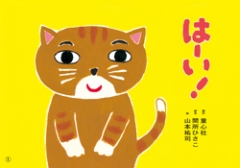
-
Ouiii!
Ha-I!
/ 8 sheets
- ISBN978-4-494-07926-1
- ¥2,750E
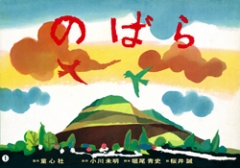
-
Les roses sauvages
Nobara
Mimei Ogawa, Seishi Horio, Makoto Sakurai / 12 sheets
The bloom of wild roses connects an aging soldier from a large country with a youthful soldier from a small country, but the two are soon parted as one of them becomes a casualty of war. The text by Seishi Horio makes the poignant story resonate even more powerfully with the audience. Makoto Sakurai’s illustrations emphasize the abrupt change from welcoming, beautiful surroundings to wartime conditions, and eloquently express the elderly soldier’s feelings in response. The importance of peace comes to reside deep in the heart.
Deux soldats, un jeune et un vieux, protègentchacun la frontière de son pays. Ils nes’adressent pas la parole, jusqu’au jour où, auprintemps, des roses sauvages fleurissent. Au fildes conversations naît alors une amitié. Mais unjour, leurs deux pays entrent en guerre. Le jeunesoldat est envoyé au front. Le vieux soldat, restéseul, prie pour que son jeune ami soit sain etsauf et qu’ils se revoient un jour ; mais lorsqueson pays gagne la guerre, il apprend la mort dujeune soldat. Une ode à la paix, derrière lacolère et la tristesse suscitées par la guerre quisépare les hommes et leur vole leur avenir.- ISBN978-4-494-07928-5
- ¥3,300E
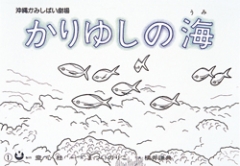
-
Une mer bienfaisante
Kariyushi no umi
Noriko Matsui, Kensuke Yokoi / 8 sheets
As everyone utters the Okinawan blessing yugafu tabori (may happiness come to us), color and life are breathed into black and white illustrations, and the ocean becomes beautiful again. The surprise and excitement of this moment are expressed with stunning photography. The sliding in and out of sheets in response to heartfelt wishes make this kyokan the unique product of kamishibai.
- ISBN978-4-494-07930-8
- ¥2,750E
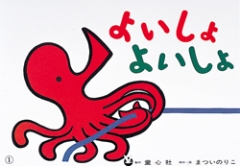
-
Ho hisse! Ho hisse!
Yoisho yoisho
Noriko Matsui / 16 sheets
As the audience calls out, “Heave-ho, heave ho!” (yoisho, yoisho) items that an octopus and horse are pulling along with cords become visible. As everyone continues to “pull,” together with a dwarf and an elephant, look there! Something special appears. The final sheet has eight different text options on the back, so the ending can be tailored to introduce an activity or connect with a story. This is one of the few kamishibai destined to be performed without the stage.
- ISBN978-4-494-07931-5
- ¥4,070E
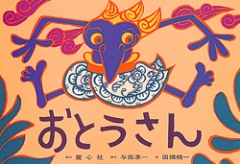
-
Le vrai pere
Otosan
Sumatran Folktale, Jun’ichi Yoda, Seiichi Tabata / 12 sheets
Seiichi Tabata’s superb illustrations for this work clearly show unique characteristics of visual expression possible in kamishibai. In addition, they convey the love shared between parent and child and impart a sense of sympathy for the lonely (in this case, the monster Mangalan Green Beku). Poet and children’s book author Jun’ichi Yoda wrote the text for a number of kamishibai and twice received the Gozan Prize (the highest annual distinction awarded for published kamishibai).
Le monstre Mangalan Green Beku, solitaire surune île du sud, voit un jour un père et son filsjouer dans une rivière. Envieux, il entonne unedrôle de formule magique qui lui donne les traitsdu père. Il tente ensuite d’entraîner le garçon enlui affirmant que c’est lui, son vrai père. L’enfant,incapable de faire la différence entre ses deuxpères, va demander conseil au roi. Celui-ciordonne aux deux pères de gravir une montagneavec l’enfant dans un tambour, chacun son tour…Le contraste entre l’amour d’un père qui tente deretrouver son enfant et le Mangalan Green Beku,un monstre pas si méchant que ça, démasquégrâce à la sagesse du roi, fait tout le sel de cekamishibai qui marque les esprits.- ISBN978-4-494-07933-9
- ¥3,300E
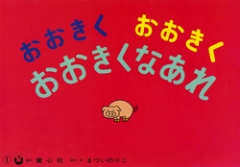
-
Gros,plus gros,encore plus gros
Okiku okiku okiku na-are
Noriko Matsui / 8 sheets
This bestselling kamishibai won the 1983 Gozan Prize. Picture book and kamishibai author Noriko Matsui experimented with unique aspects of the format to open up the new world of audience-participation kamishibai. As viewers of this particular work take part by saying, “Grow grow grow bigger!” they voice the universal human wish for growth. A representative work that overflows with charm.
Il était un tout petit cochon. Quand le public luicrie « Devient gros, plus gros, encore plusgros ! », à la page suivante, le cochon a grossi !Ensuite, un oeuf. Le public crie « Devient gros,plus gros, encore plus gros ! », et hop, à la pagesuivante, l’oeuf a grossi ! Mais, attention ! Lacoquille se fend. Que va-t-il en sortir ? En dernier,c’est une toute petite part de gâteau qui grossit,grossit, grossit pour devenir un gros gâteau àpartager. L’histoire progresse aux cris desenfants dans ce kamishibai fort apprécié quipermet de partager la joie du public.- ISBN978-4-494-07935-3
- ¥2,750E
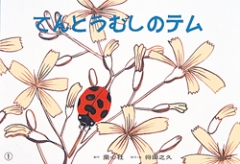
-
Tim la coccinelle
Tentomushi no temu
Yukihisa Tokuda / 12 sheets
Yukihisa Tokuda is a researcher as well as an illustrator, and his fondness for insects spills into the art and text of this kamishibai. This work not only fosters enjoyment in learning about insects, but also invites children to share, via kyokan, the joy of being alive as they follow Temu on his journey. The vivid illustrations of insects and visual progression that capitalizes on the sliding out of sheets evokes a world that could only come to life through kamishibai.
- ISBN978-4-494-07936-0
- ¥3,300E
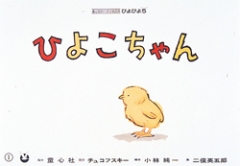
-
Bebe poussin
Hiyoko-chan
Kornei Chukovskii, Jun’ichi Kobayashi, Eigoro Futamata / 12 sheets
A work by Russian author Kornei Chukovskii is rendered in verse-like text by poet Jun’ichi Kobayashi. In order to produce kyokan through communication, which is uniquely possible in kamishibai, the text repeats language such as hora (look here!), konna fu ni (like this), ne (you see?), to striking effect. Eigoro Futamata’s simple and lovely illustrations combine with the beautiful text in this long-selling kamishibai.
- ISBN978-4-494-07938-4
- ¥3,300E
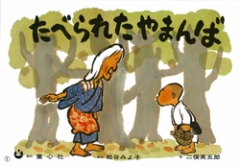
-
Yamamba ou comment gober une sorciere
Taberareta yamanba
Miyoko Matsutani , Eigoro Futamata / 16 sheets
This kamishibai retells the popular Japanese folktale Sanmai no fuda, or The Three Magic Charms. Miyoko Matsutani’s excellent text develops themes that run through the heart of many folktales: living life with spirit, the wisdom and strength to be found in common people. Eigoro Futamata’s illustrations deftly convey the atmosphere of the folktale and make expressive use of the kamishibai format. This work has come to represent folktale kamishibai both in Japan and abroad.
- ISBN978-4-494-07939-1
- ¥4,070E
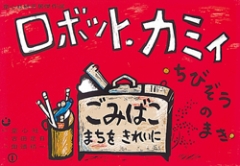
-
Robot kamii chibizounomaki
robot kamii chibizounomaki
Taruhi Furuta, Seiichi Tabata / 12 sheets
Children’s dreams of eating lots and lots of cake become connected with something much bigger in this kamishibai, which overflows with life. The children’s longing for cake becomes the wish to build a future in which everyone in town is happy; the development of this connection invites a rich sense of kyokan. The kamishibai makes the most of a fresh creativity and laudable perspective on children that could only have come from Taruhi Furuta and Seiichi Tabata.
- ISBN978-4-494-07940-7
- ¥3,300E
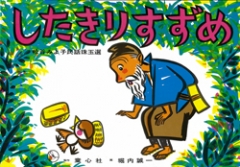
-
Le moineau a la langue coupée
Shitakiri suzume
/ 16 sheets
Il était une fois un grand-père et une grand-mère.Un jour, le grand-père rapporta de la montagne unmoineau ; il s’en occupait tellement que la grandmère,jalouse, priva l’oiseau de nourriture.Lorsqu’elle découvrit que l’oiseau affamé avaitmangé de la colle de riz, de colère, elle lui coupa lalangue et le chassa de la maison. Le grand-pèrepartit à la recherche de son oiseau bien-aimé pours’excuser. Après avoir répondu aux énigmes d’unhomme qui lavait son cheval et d’un vacher, il trouvala maison du moineau qui, pour le remercier, luioffrit un cadeau. La grand-mère, envieuse, décidaalors de rendre visite au moineau, mais…Le contraste entre les personnages du grand-père etde la grand-mère, le rythme de l’histoire et lesillustrations charmantes font de ce kamishibai unevaleur sûre au succès jamais démenti.
- ISBN978-4-494-07942-1
- ¥4,070E
